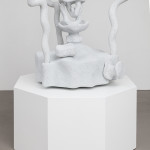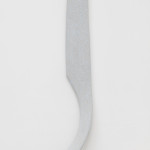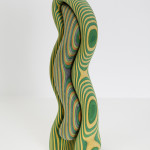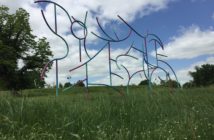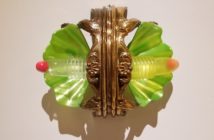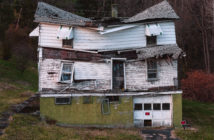Bayne Peterson graduated from RISD in 2013 with an MFA in sculpture. This year he has exhibited work in Brooklyn, Cambridge, Providence, and Philadelphia. He received a Graduate Studies Grant in 2013, In Search of the Primus Stove Carver. His exhibition Myst, curated by Tabitha Piseno and Sam Keller, was on view at Proxy (270 Westminster St., Providence), the recently opened exhibit space of the creatively mobile curatorial team at RK Projects, from October 16 — November 14, 2014.
Peterson’s process is tied to the practices of information gathering and transmission. In the early 20th century, on Baffin Island in Nunavut, Canada, an unknown Inuit artist created a small, only 2.5 inch, carving of a Primus stove, made of walrus ivory. Peterson studied this carving, based on images, before taking a research trip to the Canadian Museum of Civilization to research it in person, drawing and sculpting its form, and speaking with Inuit artists. The original object, in his description a "precise, manufactured metal stove" would become the Museum’s "somewhat softer and more fluid version in walrus ivory," before its scale was changed in his own much larger sculpture; finally the stove’s dimension of existence changed again in a 3D modeling. The trip north, and later, time spent in Miami, inform all of the works on view, with the latter location especially influential in the creation of variously sized, dynamic arms of sunglasses.
Fiberglass, wood, tinted epoxy filler, 2013
The exhibition at Proxy plays on the idea of the familiar and alien qualities of virtual rendering, and the way a combination of virtual signifiers and sculptural work can push towards the sensation that one is in the presence of, in Peterson’s words, "the uncanny." Peterson noted that a work like Brancusi’s Bird in Space, once "associated with the tactile" is now associated just as easily "with the intangible," since rendering allows for the digital creation of such compound curves, and our understanding of digital capabilities now affects how we perceive the three-dimensional. The ontological classification of these objects is destabilized. Peterson cited artists like Ken Price, Camille Henrot, Tauba Auerbach and Ara Peterson as others exploring the state of tension produced by dislocations of texture, rhythm, and pattern.
Among his sculptural works in Proxy’s gallery, Peterson gave a presentation centered on his travels. A video taken en route to the Arctic formed a cornerstone of his talk. From the window of a small plane, fields of ice interrupted with gray furrows spread in sunlight; it’s summer, and the ice floes are melting. What read as a series of boundary lines from above is dark water beneath the level of protruding ice, creating a tangible border from this aerial perspective. I better understood Peterson’s preoccupation with surface after seeing this video; his repetitive, precise marks subtly teeming over form call into question the divide between object and surface, and the perspective that creates these divisions.
The video served so well as an introduction, however, because vision is not simply transmuted into process or interpretation. Just as Peterson transparently displays the crossover between the virtual and tactile, in this exhibition he also presents the overlap between the objective and subjective experiences of research, and explores the creation of information.
.................................................................
Rachel Shipps: I wanted to start off with the title [Myst]. I know you talked a bit about that in your artist’s talk. So, how do the objects we see in the gallery relate to the [early 90’s computer]game in your opinion?
Bayne Peterson: The idea for the title actually came from one of the curators of the show, Tabitha Piseno. It started out as a comment that Tabitha made about the surfaces on the sculptures reminding her of textures in Myst, and that was interesting to me because that got at the relationship between the physical and the virtual. Or the handmade and the high tech, which is a relationship that I’ve been actively trying to explore in my work. The digital as kind of counterpoint to analogue or handmade, but at the same time the theme of the game itself, where you’re a character called the Stranger and you’re dropped onto an island.
At the beginning of the game you have no idea what’s going on, you just have to explore and kind of figure it out. Actually, when I first played Myst I spent hours getting nowhere, just wandering, and I think a lot of people have that experience too. That process of going through that and responding to place, responding to objects for clues, books—there are books in the game that you have to open and read through, objects that you put together to form the bigger picture of the environment and how to proceed within it. I felt that was a really good analogy for the process of research, for critical thinking and for responding to place, which is another element that I’ve been trying to pursue pretty actively in my work as well. And similar to the relationship of the handmade and the digital, I feel that it’s another dichotomy.
Where you have a studio practice that can be insular; I get into my own studio and into my own head, then find ways to totally subvert that . . . and be the Stranger, really. Even just that [phrase]I think is really important to me, "being the Stranger"—because when you’re the stranger everything’s unfamiliar, even things that would normally seem just banal. So I try to put myself into that position of being the stranger and looking at things in a fresh way. I think there are a lot of ways in which Tabitha’s analogy really resonated with me, and as we were working through the conceptual framework for the show and choosing a title there was no other option in my head. That was it for me.
RS: That’s interesting. As a stranger you inherently have to be conducting research in order to survive in this new place. Actually, that leads into a few other things I was thinking about. I saw that you had gotten this grant specifically to go study the Primus stove and its makers. In that frame of mind, in researching this specific thing and its making, did you go in with specific questions about it? Or was it more of an immersive, experiential research endeavor for you?
BP: I definitely went into it with the basic practical questions of who, what, where, when, how, why. And then I was very interested in finding answers to those. But at the same time there was another level to the inquiry which had to do with form and representation. I was approaching it both as a standard researcher and then also as a visual and formal researcher, which was an interesting thing to navigate on the ground in the special collections at the museum: I’m working with people and they have expectations with me as an art historian or an archaeologist or anthropologist—which I’m not. So going back to the formal and representational line of inquiry, I had been working on a series of sculptures based on the sculpture even before I saw it in person. I was interested already in the layering of representation there.
First, it’s a walrus ivory sculpture of a metal stove. So it already kind of embodies these two disparate material and functional situations, and then one is layered on top of the other. So that to me was as interesting, if not more, as the who-what-where-when-how. Just as an object, independent of its maker, independent of its context, it’s already doing things in the world, in space. And then my process with it, my way of engaging with it, was to try to make my own sculpture of it in wood at a larger scale. And at first it was very straightforward sculptural approach of just trying to recreate it, to really represent it, which is not something I always do. And even before going to the museum, that was research—to try to sculpt something or to try to draw something is a form of researching and a form of trying to understand it. So that was my frame of mind when I went to the museum, and then to see the thing I had been representing in the round and to see it disassembled.
Then, talking with people at the museum, it was really interesting to me how little is known about the sculpture. That was as interesting as whatever I would have learned about it: the fact that so little was known about this mysterious thing, that the artist is unknown. He or she is in a sense also the Stranger, a nameless character in the story of these stoves. Even though it’s only a hundred years old, nobody knows exactly where on Baffin Island it was made. The mysteriousness of it hints at the fact that these carvings were often considered souvenirs rather than art objects. Therefore, details about their origins and authorship were seldom recorded.
RS: Is there also a different notion of authorship, do you think, among Inuit carvers? I know you met a lot of artists while you were up there. Do you think that’s also part of its mysterious lack of attribution or place of origin?
BP: Yeah, I think that’s part of it too. I mean I think it’s both . . . but I think it’s also true that these weren’t necessarily valued the way they should have been by the people who ended up receiving them.
Wood, tinted epoxy filler, 2013
RS: It struck me, having seen the exhibit, that these things sort of have an echo of bodily relationship, even in the arms of the sunglasses. I feel like you conceptualize them in space as you would in relationship to a body, like a ghost of their function. I was wondering, especially in light of [the show]being Myst and implying that we’re all in the position of The Stranger, were there any ways you thought of people interacting with the show, or with the gallery? That’s a long question...
BP: It’s an interesting question. In terms of the body, I think they all have a relationship to the body. But as you said, it’s more present in the earpieces where they are objects that are made to interact with the body and at a scale that we understand on a personal level. And then taken out of that, I think it plays with that association with the body, towards something that does it in kind of a different way, through anthropomorphism, slightly—I mean there’s a pose and gesture to them that relates to the figure.
RS: Your piece with the knots, called Knots, I thought . . . that tied in a little bit to what you said about this process of problematizing the crispness of an object. You talked in your discussion the other day about the knots being this complete repository of information and you’re subtracting information away from them. I wonder if you could talk about that a little more, for people who weren’t there. But also it seemed like you were adding surface information just in terms of color and I was curious about how that plays into that subtraction and addition of information, and maybe how it plays into these being mounted on the wall.
BP: I like the idea of a perfect form, because it’s an idea that relates to resolution. And also, these forms can be technically perfect. You know, mathematically totally precise—no matter how far you zoom in on it it’s just that precise. So pushing it towards that place but stopping at a certain point. Then conversely with the digital work, starting from that place of perfect virtual form and backing it up in this ambiguous middle ground, between the tangible and the virtual. So with those it was a way of isolating information, and translating it to a process that’s actually very nuts and bolts building, really—just gluing and nailing wood together. That’s really how they’re made.
And then, I don’t actually want to stop there. I don’t want to stop with a wooden sculpture; the paint and the finish is actually a way of pushing it back again. It’s like going back and forth on this spectrum between the handmade and virtual.
Then, mounting it on the wall, in conjunction with paint—wall space is an inherently intangible space. I mean freestanding objects, you relate to them in a very physical way: they’re in your space, you may not always touch them but they feel physical, they feel material. And the wall space, traditionally it’s been an immaterial space; the idea of the painting as a window onto a world downplayed the object of the painting for centuries, until modernism. But it still has that association of non-objecthood, which I think relates to ideas of the virtual and so I think situating objects on the wall, it kicks them into more of that idea, or imaginary existence, rather than the actual physicality of the object.
RS: Would you say your playing with scale, or pushing scale back and forth, is serving a similar purpose to what you were talking about with your use of color—to swing it back and forth, in a semi-representational, semi-tactile space?
BP: I’m glad you brought up scale. I think it is similar in that it plays on a spectrum between familiarity and the unfamiliar, so with the earpieces, for example, they’re on a scale that is rational because it measures the body. I mean it’s based on an actual distance on the body, so in that sense it has a really logical scale in relation to us physically. And then to depart from that, I think it pushes them into this totally unfamiliar place. And you know, in the talk I brought up Camille Henrot’s video Grosse Fatigue, and I think part of what interests me so much about that video is the fact that it all plays out on her [computer]desktop.
You think about the desktop and it’s this very familiar, personal scale situation that you are very used to interacting in, and yet she’s using it as a portal to almost infinite space, or maybe even literally infinite spaces. So it’s the ability of an object to both very directly reference a small personal intimate scale, an intimate scale in relation to our physical understanding of the world, and to have it simultaneously veer into something vast and unfamiliar, like new territory. I think ultimately I want them to be doing both things at once. And I think the finish contributes to this, relating to the idea of the sublime or of being overwhelmed by something much larger than oneself.
RS: An interjection of one scale of space into another space does sound like the sublime. I like that establishing a constraint so that you can explode it, which it sounds like you both are doing.
I was curious what you think, I think you mentioned Henrot’s airplane wings (The Price of Danger) as well, and since those also had, it wasn’t a surface in that case, it was things cut into them, but almost like a pattern laid on top of a pattern. It was an instance of her drawing upon patterns from different places, and I was wondering if that relates to what you’re doing at all, since you have these very distinct places that have been instrumental in your research, and if that surface or finish sort of references something else. Maybe that’s again what you were talking about the sublime, but does that finish also reference place, or does it just refer to an altered visual state, or state of understanding?
Fiberglass, wood, tinted epoxy filler, 2014
BP: Well, yes, to place. The two places that I most wanted the show to be drawn from were the Arctic and also Miami. And so I think I drew on both of them to make the work, and sometimes both of them within a single piece, sometimes both more directly one. My two newest earpieces were actually the most ambivalent in terms of place. Because for me the Arctic was very much about light. There were almost 24 hours of sunlight, and more of a visual neutrality. And not just the Arctic but also in Ottawa, researching, in terms of color; the consistency of the ivory as this neutral finish. And then Miami being very much about color and sound and noise and eclectic influences . . . more of a diversity of cultures meeting, but definitely this emphasis on color and pattern, and I think the three [older]earpieces most directly reference this vibrancy of color and pattern. The two newest ones are actually just white and gray from afar but then close up, have a multitude of colors, but they’re all almost under the surface, with outlines around every single mark.
But it’s like starting from the Miami color and the influence of that place, and then turning it down to 1—like starting from 10 on the dial and turning it down to 1. And letting an overriding neutrality dominate with undercurrents of color. And I especially felt that on my backpacking trip above the Arctic Circle, where a lot of times I really was shrouded in mist. And it was just this feeling of general neutrality of color. This feeling of a personal kind of neutrality is one way to describe it: a total removal of a lot of cultural noise that is sort of a constant backdrop. Not just in Miami, but in Providence, anywhere. Where all these things are swirling through my head, and to remove—I’m actually a really bad insomniac, and I haven’t really slept well in 4 or 5 years, but when I went to the Arctic I instantly started sleeping like a baby. Every night I would just fall asleep and sleep all night, and I think that relates to this feeling of place that I’m describing with the Arctic, which felt not just like a visual neutrality but like a meditative kind of removal.
RS: Like a total larger sensory neutrality. I’m glad you put it that way too, like turning the volume way down, because I thought about what you talked about the other day: working with Jim Drain and that experience of color being analogous to chords or single notes or many notes at once, and just having this rhythm to that visual. I was curious how that plays out in your own work, aside from the ones you talked about. How do you see that musicality of color playing out in the things you’re doing?
BP: For me, personally, I’m thinking about ambient sound; I’m thinking about really low level almost static in a lot of the finishes, and the nuance that arises from quietness. So a super restraint, especially in the newer finishes like on the large Primus stove and the newest earpieces. And I’m thinking about neutral colors; there’s a general predominance of this neutral pale green and these sort of gray off-whites. I’m really interested in off-whites, and how there’s a power to them too in that they’re so flexible. Almost chameleon-like, in how they shift depending on light conditions and contexts with other colors, so that’s what I’m really looking at right now: these really subtle quiet color shifts that actually do powerful, almost sub-visual things. And it’s a temperature thing too, it’s not just tone. I’m thinking about warmth and coolness and I think that relates to place too in terms of the climate of places where I’ve been—the coolness of the Arctic and the warmth of Miami—but kind of the contradictory nature of being in the Arctic in the summer and then being in Miami in the winter and that kind of warmth and coolness. In the large camp stove the predominant color is a cooler sort of lime green-tinged off-white, and the secondary color is a warm cream, or peach color. So . . . it’s about putting multiple temperature situations into a piece and then multiplying that effect in a really quiet, small way.
RS: That does help with your description of ambient noise. In all these different settings, how do you differentiate between experience and research, or are those kind of the same thing if you’re thinking about being in these places, and taking things from each of them? Do they blend together?
BP: I think they definitely blend together. And like I was saying before about the different methods of research (researching as an artist or researching as a more analytical person) I’m trying to be both all the time, and I’m searching for surprise and serendipity. And I talked about that in the talk a bit, where the best moments were serendipitous—they were when I was looking for one thing and found another. And so there’s no one way to do that, just as with art—there’s no one way to make art. I mean art is, to me, about exploring the unknown, and the wonderful and frustrating thing about it is you don’t know what that is.
So I think research and experience . . . maybe my approach to it is more of being comfortable with the unknown and not trying to find all the answers. Or that not being the point, where I’m interested in exploring ambiguity and things existing between clear-cut answers.
RS: Because so many of these objects in the show are relational in terms of the body, how would you expect people to interact with them in the gallery, as ‘Strangers’ themselves, or have you witnessed any particular way people have of interacting with them?
BP: People want to touch them.
RS: That doesn’t surprise me.
BP: And you know, I’m interested in that. And I think that comes down to desire.
RS: Maybe even that double desire of wanting to touch something that reads as both tactile and virtual, like especially in that wood cut—so, I know very clearly that you use multiple reference points in both of those arenas, and maybe there’s something doubly enticing about accessing something that’s not in one.
BP: Touch is a motif that is pretty recurring in the work. So there’s the idea of touch, something that’s smooth that you want to run your hand over. Or in handcraft, or in the Primus stove. When I saw it for the first time, I noticed little things that I hadn’t noticed in the picture, like the tiny little scratch marks of the tool, of the artist’s hand. So in a way—though I will never actually know who made the stove—in a way I know the person’s hand a little bit. So that’s a way of knowing an unknowable person through touch. But then also this spectrum of the tangible to the intangible, where as I’m pushing this more and more . . . you know, I sort of talked about Brancusi in terms of the tangible, and I think with Bird in Space it’s an attempt to make material transcend material and just be this pure thing, just in space. And so it’s something that’s achieved through a lot of touch, but then it’s sort of attempting to lift off from touch. So I think that’s what I’m playing with, is that kind of push, but at the same time maybe the more something seems to depart from the tactile the more you kind of want to reach for it and touch it and see . . . like in Indiana Jones, where he threw sand on the invisible bridge. So doing something to establish a tactile or physical relationship to something that may or may not be a trick or an illusion. And that’s part of what interests me about 3D modeling, virtual reality, is the illusory quality of it.
RS: And some of your finishes I think read as illusionistic in this very, not mechanized, but digital way, maybe people try to bypass that or seek to bypass that with the tactile.
BP: I’m really interested in faux finishes, you know. And kind[s]of visual tricks, illusions. What interested me about the finish in the large camp stove was how it started to move like stone. And there’s a quality of the material where you get close to it. [There are] nooks and crannies in it which kind of read like, it makes it read more like stone, or some kind of cementitious material—concrete, an aggregate of some sort.
RS: As if it’s been worked upon in some natural way over time.
RS: In terms of souvenirs of trips, of what people bring back, do these [works]function like that for you? Are there things you want to hang on to, or perhaps processes that they’re an anchor for?
BP: I don’t really think about them as souvenirs because I don’t want to hang on to them, really. I mean I make them and move on. I think "souvenir" kind of implies an attachment to the object that I don’t have. Where for me it really is more about pure experience; if the process of working on them is a sort of souvenir, then maybe that’s true. But as objects, I think they’re more like . . . maybe "memorial" would be another word.
RS: In that they’re something that’s past for you, in the past of your own life? In that sense they’re more memorial than something you keep?
BP: There’s an element of preservation, capturing or preserving something. I think that’s definitely the case.
RS: Right. I think of souvenirs as kind of . . . things [that are]ostensibly to remind you of a place or your experience but in reality it’s not representational of that at all. Usually it’s more of a gesture, not really descriptive of what I think these actually are. But I’m interested in that language of memorials, because so often I think memorials are more directly related to whatever they’re referencing, even if it’s an inscription. And that’s a little bit literal, but that direct signifier of something else.
BP: If you’re working with history and you’re working with narratives that are maybe underrepresented, then I think "memorial" does implicitly come into that a little. I do want to memorialize the Primus stove story. I think that story is important; it’s important to me that it be told. So I don’t think of memorial in terms of like, the sort of permanence of it or making a plaque that would be there forever to tell the story . . . I just think of it as a vehicle of storytelling. And I like that these objects . . . they’re not just objects, they’re vehicles for a story.
I had a conversation with an artist in Pangnirtung (on Baffin Island), Jaco Ishulutuq—we talked about that, actually . . . [W]e were talking about "what’s the value of art," you know. Great question. He was like, "Conversations." You walk around town holding a sculpture, somebody’s going to be like, "What’s that?" and you’ll have a conversation about it. And I think they really are just things. They really are just objects. But then how else do you have these conversations with people? We have language, but sometimes I think the best way to start using language is through a non-language based medium which can kind of spark all these other things. And when you’re telling stories about a non-language based history, it seems appropriate to use a non-language based method of describing it.
. . . I think about these being like time capsules; you invest it with information and then it’s stored within, and that’s partly where it starts to make sense with the game Myst, where it’s narrative story within object. It’s kind of the idea of a meme, or how memes function, where [it’s] basically like a package of information that somebody disseminates and then it takes on its own life, reproduces and navigates.
- Bayne Peterson Knots, Wood, paint, 2013
- Bayne Peterson IIV-X-6236b, Wood, paint, 2014
- Bayne Peterson IV-X-6236c, Wood, tinted epoxy filler, paint, 2014
- Bayne Peterson Earpiece 16 Fiberglass, wood, tinted epoxy filler, 2014
- Bayne Peterson Earpiece 5 Fiberglass, wood, tinted epoxy filler, 2013
- Bayne Peterson Earpiece 9 Wood, tinted epoxy filler, 2013
- Bayne Peterson Untitled Dyed plywood, 2013
This interview has been edited and condensed for clarity.










